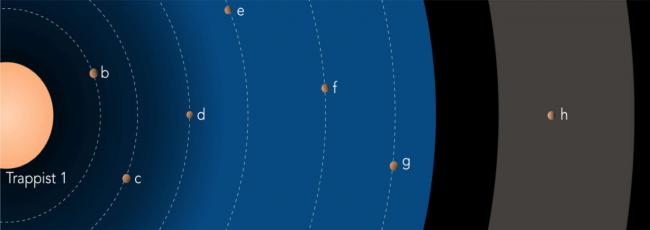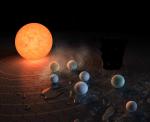Seven planets of terrestrial size and moderate temperature gravitate around the star Trappist-1, a small cool red star located at 40 light years from Earth. Better: at least three of them are in conditions compatible with the presence of liquid water on their surface. This was discovered by an international team involving CNRS, CEA and UPMC researchers at the Astrophysical Laboratory of Bordeaux (CNRS / University of Bordeaux), the Laboratoire de Météorologie Dynamique (CNRS / UPMC / École Polytechnique / ENS) and the Astrophysics Department - AIM Laboratory (CEA / CNRS/ Paris Diderot University). The planetary system orbiting the star Trappist-1 is one of the most astonishing and richest, especially in terms of scientific prospects: beyond the determination of the orbit and the mass of these planets, it will be possible, in the near future, to highlight the possible presence of atmospheres. This study is published in Nature, 23 February 2017.
The Ballet of the Seven Earths
At the beginning of 2016, photometric observations (high-precision luminosity measurements) by ESO's Trappist telescope and NASA's Spitzer space telescope revealed the presence of three Earth planets around the star Trappist-1. (Trappist-1b, c and d). This planetary system is oriented in such a way that these planets pass before the disk of the star at each orbit, causing a decrease in luminosity called transit. The amplitude of these transits makes it possible to determine the radius of the planets while their periodicity indicates their orbital distance and therefore their insolation.
Since these first detections, this system has been systematically followed to look for possible other planets. The result of this monitoring exceeds all expectations: Trappist-1 has at least seven planets, all of similar size to Earth (plus or minus 15%). The six nearest planets (b to g) revolve around their star in 1.5 to 12 days (the period of the seventh remains to be determined), which places them 20 to 90 times closer to their star than Earth is from the Sun. At these distances, the tidal forces exerted by the star are considerable and impose on the planets a so-called synchronous rotation, that is to say that the planets makes exactly one turn on themselves during their orbit, thus always showing the same side when facing their star (like the Moon in relation to the Earth).

The planetary system around Trappist-1. Object sizes are scaled, but distances are reduced by a factor of 10. The color of the star is realistic. The bluish zone indicates the region where the presence of liquid water is possible on the surface of the planets. The shaded area indicates the possible range of orbital distances for the planet. © Franck Selsis, Laboratory of Astrophysics of Bordeaux (CNRS / University of Bordeaux).
The planets of Trappist-1 have insolations, and therefore mean temperatures, close to those of the Earth: the innermost (b) has an insolation slightly superior to that of Mercury, while the more external (g and h) have a insolation a little lower than that of Mars.
At least three of the planets (e, f and g) have insolations compatible with the existence of surface liquid water for a wide range of atmospheric compositions, as shown by numerical simulations of their climate. On the more illuminated planets (b, c, d), and thanks to synchronous rotation, the presence of liquid water is not strictly impossible in temperate zones with little or no illumination.
The orbits of the planets of Trappist-1 are in resonance with each other: when the planet (g) accomplishes a revolution around its star, the planets b, c, d, e and f have respectively made 8, 5, 3, 2 and 4/3. This very particular architecture is predicted for planets that have migrated to their star in the gas and dust disk within which they have formed. These resonances favor the rapprochement between planets and the gravitational interactions. For this reason, transits do not succeed each other perfectly periodically but occur with advances or delays sometimes of more than one hour. This effect makes it possible to constrain the masses, whose determination is still not very precise, and therefore the densities, of these planets. Current data suggests that some of the Trappist-1 planets have low densities and are rich in water, a finding to be further refined through ongoing observation monitoring.
In many respects, the cortege of the planets of Trappist-1 recall the systems of satellites gravitating around Jupiter and the other giant planets of the Solar System, perhaps indicating similar mechanisms of formation. The very small size of the Star Trappist-1 (only 12 times the radius of the Earth) and its low luminosity (0.05% of that of the Sun) offer exceptional conditions for observation of its planets. Thanks to the future space telescope James Webb (NASA and ESA) which will be launched next year, it will be possible to highlight possible atmospheres and to characterize some of their properties. With Proxima b, discovered last August, Trappist-1's planets are the most promising targets to date to search for possible traces of life outside the Solar System.
Contact : Emeline Bolmont
Publication :
"Seven temperate terrestrial planets around the nearby ultracool dwarf star TRAPPIST-1"
Michaël Gillon et al. (2017), published in Nature, 23 Februrary 2017.
for an electronic version :  arxiv.org/abs/
arxiv.org/abs/





